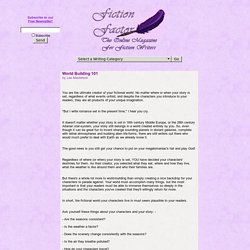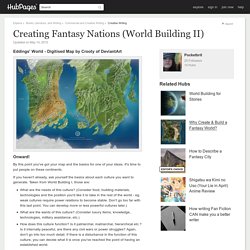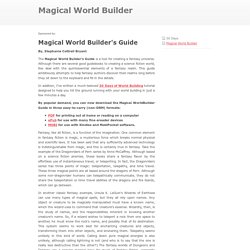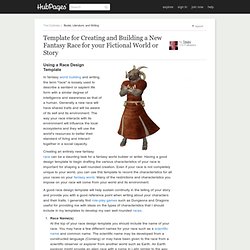

The Art of Description. The Art of Description: Eight Tips to Help You Bring Your Settings to Life by Anne Marble Return to Setting & Description · Print/Mobile-Friendly Version Description is something that gets in the way of many authors.

Why? Well, because it's so darn hard to write. And no wonder. If you're not very accomplished at writing description, then sometimes you might want to avoid writing it. At the same time, some writers err in the other direction, including too much description. How bad is bad description? Avoid Huge Lumps of Description In the past, authors could get away with including long, detailed descriptions in their stories. Unless they're seeking out writers known for lyrical descriptive passages, today's readers wouldn't put up with that sort of thing. Of course there are authors who, even in today's marketplace, can get away with pages and pages of description. 7 Deadly Sins of Worldbuilding.
World Building 101. World Building 101 by Lee Masterson You are the ultimate creator of your fictional world.

No matter where or when your story is set, regardless of what events unfold, and despite the characters you introduce to your readers, they are all products of your unique imagination. "But I write romance set in the present time," I hear you cry. It doesn't matter whether your story is set in 16th century Middle Europe, or the 28th century Altarian star-system, your story still belongs in a world created entirely by you. So, even though it can be great fun to invent strange sounding planets in distant galaxies, complete with lethal atmospheres and budding alien life-forms, there are still writers out there who would much prefer to deal with Earth as we already know it. The good news is you still get your chance to put on your megalomaniac's hat and play God!
Regardless of where (or when) your story is set, YOU have decided your characters' destinies for them. Creating Fantasy Nations (World Building II) By this point you've got your map and the basics for one of your ideas.

It's time to put people on these continents. If you haven't already, ask yourself the basics about each culture you want to generate. Taken from World Building I, those are: What are the needs of this culture? (Consider food, building materials, technologies and the position you'd like it to take in the rest of the world - eg. weak cultures require power relations to become stable. A common mistake is making each culture and nation too different from one another. Leadership makes all the difference.
The figurehead(s) of your nations work best when they are discernibly different to one another (note, in character, more than in racial traits). Remember, everything can be changed later. NamesSome people find this easy. Remember that national names will also need to be modified. Note down words you like the sound of and edit a few letters. International Relations You've established the wants and needs of these nations. Novel Outlining 101. Concept: To create a weblog post that presents a simple method of outlining a novel.

Plan: Demonstrate the method by using it to outline the post, then use the outline to write the post itself. Prologue: Outlining DemoPart One: Introduction to Novel Outlining, Definitions, PurposePart Two: Examples of Outlined Scenes, Chapters and PartsPart Three: Common problems, Suggested Resolutions, FinaleEpilogue: Links to other posts and articles on novel outlining at PBW and elsewhere I.
Novel Outlining A novel outline is a story plan, written in the abbreviated form of a traditional outline with headings and subheadings. An outline is valuable in a couple of ways: it creates a map of your novel, so you know where you're going when you write. An outline need not be lengthy or contain all the details of your story. II. The beginning of this post is the outline I wrote of it. Angel's Darkness by Temperance Rising -- Section Outline I.
A. B. C. D. Magical World Builder. By, Stephanie Cottrell Bryant <map name="admap78618" id="admap78618"><area href=" shape="rect" coords="0,0,468,60" title="" alt="" target="_blank" /></map><table cellpadding="0" cellspacing="0" style="width:468px;border-style:none;background-color:#ffffff;"><tr><td><img src=" style="width:468px;height:60px;border-style:none;" usemap="#admap78618" alt="" /></td></tr><tr><td style="background-color:#ffffff;" colspan="1"><center><a style="font-size:10px;color:#0000ff;text-decoration:none;line-height:1.2;font-weight:bold;font-family:Tahoma, verdana,arial,helvetica,sans-serif;text-transform: none;letter-spacing:normal;text-shadow:none;white-space:normal;word-spacing:normal;" href=" target="_blank">Ads by Project Wonderful!

Your ad here, right now: $0</a></center></td></tr></table> The Magical World Builder's Guide is a tool for creating a fantasy universe. Fantasy, like all fiction, is a function of the imagination. In another classic fantasy example, Ursula K. Template for Creating and Building a New Fantasy Race for your Fictional World. In fantasy world building and writing, the term "race" is loosely used to describe a sentient or sapient life form with a similar degree of intelligence and awareness as that of a human.

Generally a new race will have shared traits and will be aware of its self and its environment. The way your race interacts with its environment will influence the local ecosystems and they will use the world's resources to better their standard of living and interact together in a social capacity. Creating an entirely new fantasy race can be a daunting task for a fantasy world builder or writer. Having a good design template to begin drafting the various characteristics of your race is important for shaping a well rounded creation.